
Global Leader
You’ve seen The Cube, now QUT would like you to meet The Sphere.
Text:/ Christopher Holder
You’ve got to hand it to QUT; it knows how to make a big technology statement. There’s not an AV person in Australia who hasn’t seen or heard of The Cube. It won an AVIA and continues to create a real focal point for QUT’s outreach efforts in its Science & Engineering faculty.
So, you’ve heard of The Cube, now it’s time to get acquainted with The Sphere.
CENTRE OF GRAVITY
The Sphere is the 5m (in diameter), 3.5-tonne centrepiece of the Education Faculty building on QUT’s Kelvin Grove campus. It might look like a giant show stopper but its intent is to do more than blow visitors’ minds; rather, it’s a legitimate data visualisation and research tool for teacher training.
Gavin Winter is QUT’s Visualisation and eResearch Manager: “My mantra is to make a high-impact and memorable experience for our end users and The Sphere is doing that. It’s probably the most complicated object we’ve been given to create and we’re yet to totally bed it in, but it’s already performing a role.”
The Sphere is a Leyard product. Leyard purchased the Linzo LED factory in China which specialises in bespoke LED shapes and structures. Systems Integrator, Pro AV Solutions, did its due diligence before signing off on the order. Shannan Brooksby, Pro AV Solutions’ Education Sector Sales Account Manager in Queensland picks up the story: “Initially we were looking into a German built product that weighed five tonnes and would take one and half years to manufacture and assemble, so we had to pull the plug on that. We went down a couple of other rabbit holes — at one point I had six Russians in New York chasing me for a purchase order on another product — until we heard from Midwich that Leyard had procured Linzo LED and they routinely built LED spheres. After a few iterations, factory visits and factory tests we were satisfied we had the right product.
“We made a few modifications to the design — we developed gantries and ladders inside the sphere — and we also rewired the mains power distribution, all to comply with Australian safety standards.”
The Sphere arrived in two shipping containers. Inside were nine crates and the steel core of the sphere in its own box. It was now ready for assembly… all while the builder was finishing construction of the building.
Shannan Brooksby: “The first thing to be hung was the central shaft. It was temporarily rigged up on the load point and then the skeleton was assembled on the spine. Did it all slot together millimetre perfect? No, there was various things we had to do to get the Sphere fit for assembly. But once it was, we started assembling the LED tiles, starting at the ‘equator’.
“There was approximately 1500 hours of work, with up to eight people on site on any given day. Not everyone was suited to working inside The Sphere. It was a learning experience for everyone involved.”
WHERE ELSE?
The Sphere is the most recent and most impressive example of such an object but it’s not without precedent:
Rio de Janeiro Museum of Tomorrow.
Tokyo’s National Museum of Emerging Science & Innovation OLED globe with 16 channels of audio.



IMMERSIVE AUDIO
The monumental LED sphere is the jewel in the technology crown, but QUT hasn’t skimped on the audio aspects. A multichannel Bose EdgeMax in-ceiling speaker system is distributed on two levels of the faculty, allowing for an immersive experience regardless of the viewer’s vantage point.
Each loudspeaker is addressed by its own amp channel via Dante, using QUT’s network infrastructure. And via the Bose DSP, sound designers can tailor the audio to the 12 audio zones of The Sphere and an additional two audio zones for the adjacent Data Wall. It’s a mouth watering prospect. Already the media team are considering how to match audio to the point of view of the observer of The Sphere.
Gavin Winter: “I’ve always maintained these projects can’t leave audio out of the main concept development and thankfully there’s now capacity there for content developers to use.”
Originally the plan was to install Bose Professional’s new MSA12 Panarray column loudspeakers. But the architect put the kibosh on them due to structural concerns. But Shannan and Gavin both agree that it was for the best.
Shannan Brooksby: “EdgeMax is a brand new product that’s predominately designed for classroom and meeting spaces. The beauty of EdgeMax is you can locate it at the perimeter of the room and it will provide an even audio coverage into the space. These loudspeakers fit the space perfectly. They’re virtually invisible, and they perform superbly — there’s an immersive quality to the sound and it’s very even regardless of where you’re situated.
“We had the chance to conduct some very cool test driving one evening and we had a whole gallery of faces pressed up against the glass of the adjoining library building. It sounded like a nightclub. These speakers have helped create a high quality venue atmosphere.”
At most other times EdgeMax provides something far more discreet — not treading on the toes of any of the nearby classrooms and huddle spaces.
Gavin Winter: “One of the Deans of Research in the Education Faculty bailed me up recently, saying how much he’d enjoyed the ambient bird sounds I was running through the Bose system during commissioning, and could we have them back. It was amazing how calming that looping soundscape was, especially in the context of the internal gardens in the building.”
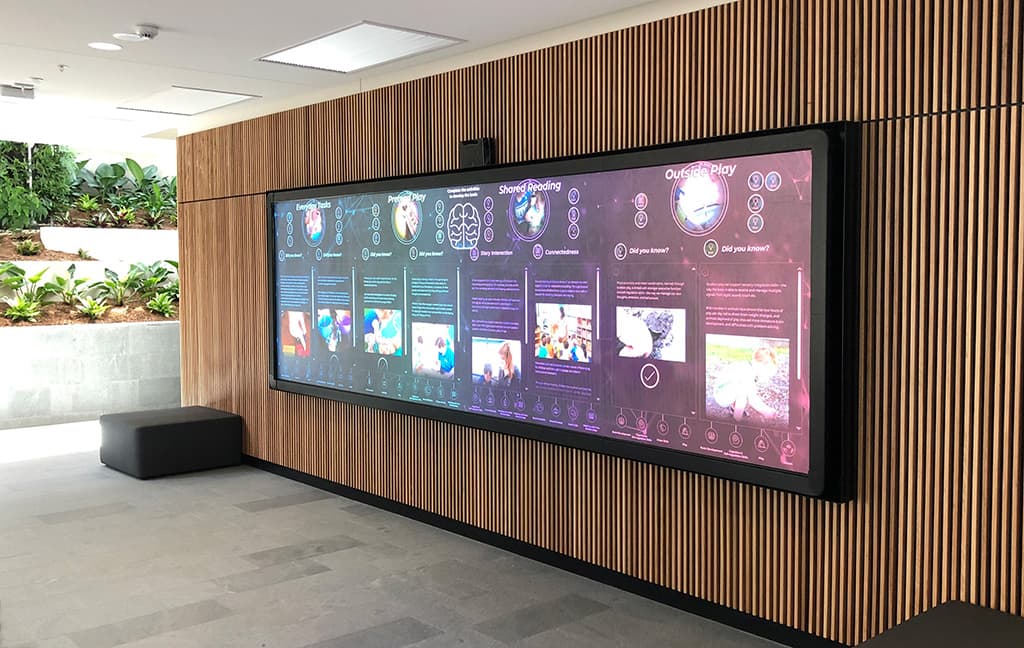

VR SPHERE SIMULATION
Gavin’s media team has got their work cut out for them. A huge LED installation such as this is a very hungry beast, voraciously demanding content when it’s not being used for research purposes.
The media server (called a Splicer) breaks The Sphere’s pixel canvas up into 24 vertical segments. The resolution is approximately 5K.
Gavin Winter: The Splicer shows us what will get lost in the content because of the geometry of The Sphere. What’s more we have a simulation package that allows us to use VR to look at the content on a virtual Sphere — to see the content before you run it on the real-life Sphere. It’s especially valuable to future developers, even off-site developers, who might have existing media they’d like to see rendered on The Sphere. The point of view of the VR simulation is from within The Sphere, with the content mapped out around you.”
BRAIN PROJECT
An early Education Faculty project that allows the Sphere to stretch its legs somewhat is the Brain Project, which pertains to early childhood brain and neurological development.
Gavin Winter: “The first thing we realised was the brain is not a sphere. That was the initial challenge. So we didn’t want to make the content on The Sphere a literal visualisation of the brain and its activity. But the dynamic graphics on the Sphere complement the data on the Data Wall. It demonstrates that the two working together are much great than the sum of the parts. It tells another story entirely.
“The Sphere is so imposing that you have to engage with it differently. You have to stand back. You have to spend time on the next floor to experience the upper half of The Sphere.”
THE POSSIBILITIES
For Gavin and his crew it’s all about the possibilities. Already the many cogs are turning and The Sphere will doubtlessly come into its own.
For Shannan and his crew, they’ve signed QUT up to a three-year service deal. There’s a generous 20 percent complement of spares on site, with a full gamut of LED tile shapes (20 in all) and circuit boards, just in case. Servicing The Sphere is a non-trivial exercise. It’s lowered and the technician needs to enter through a hatch at the ‘south pole’. When powered up, it’s an uncomfortable 50°C inside The Sphere. If a LED tile needs to be replaced, a second technician needs to assist from the outside of The Sphere, on a scissor lift.
The powering up/down is to be sequenced and controlled via the AMX control system, as is the motor of the winch.
Gavin mentioned that there was some pressure from certain quarters to source the LED Sphere directly from China – presumably to save dough. Gavin’s left in no doubt he made the right decision to push back and partner with Pro AV Solutions and Midwich as the Leyard distributor.
If you’re in that neck of the woods, it’s well worth paying The Sphere a visit. It’s open to the public. As you gaze up at in wonder, you’ll no doubt have a brainwave application of your own.
Me? I can’t stop thinking about the Death Star.

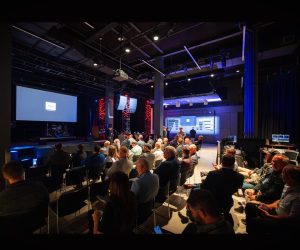
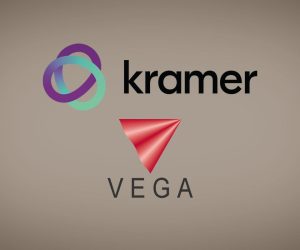






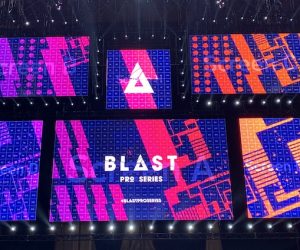
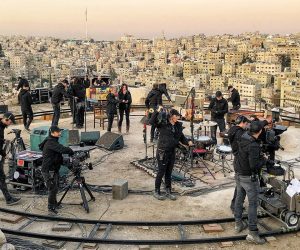




RESPONSES